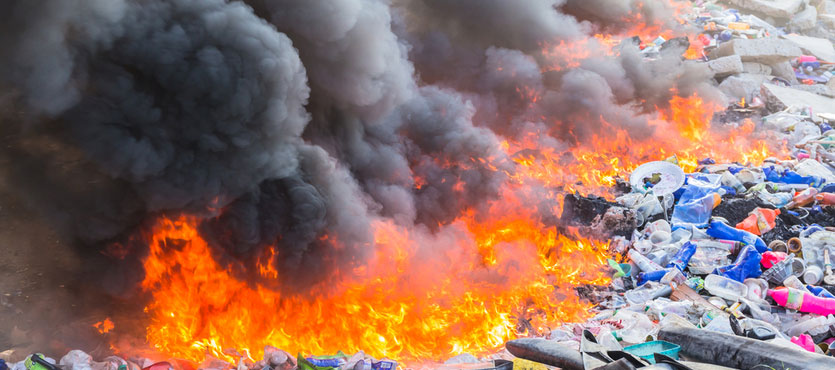The human rights organization filed a Freedom of Information Act request with the federal government for information about the large garbage disposal pits that the military used in Afghanistan and elsewhere.
To date, more than 100,000 veterans of the South Asian campaigns have complained of various respiratory illnesses, and according to AIUSA Security Director Daphne Eviatar, these individuals and their families “deserve to know whether the government is properly investigating burn pits.” The FOIA request involves information regarding the DoD’s compliance with laws and regulations about burn pits, the operation of said pits, and the possible health effects on anyone who was downwind. A number of independent studies have determined that there is at least a probable link between burn pit exposure and respiratory illnesses, especially if the person had any preexisting conditions.
“Transparency is essential in order to ensure public accountability on behalf of veterans and civilians,” added AIUSA attorney Suzanne Starr.
The Military’s Use of Burn Pits in Iraq and Afghanistan
Thousands of troops produce a lot of waste, and when these troops are stationed in remote areas for extended periods of time in a hostile war zone, the waste disposal problem is even more acute. So, field commanders authorized large burn pits in these areas, despite the fact that DoD regulations frowned on their use because of the potential health hazards. These hazards include the release of toxic gasses when normally non-combustible items, such as medical waste products, plastics, rubbers, and metals, are incinerated at high temperatures.
These burn pits in Iraq and Afghanistan quickly multiplied in terms of both their number and size. At one point, the burn pits in Afghanistan operated 24/7/365, taking in about 400 tons of waste every day, and the sprawling burn pit near Iraq’s Balad Air Base took in about 200 tons of waste per day. The 10-acre open pit was nothing but trash upon trash doused in jet fuel and set aflame, so it resembled something out of Dante’s Inferno. One witness said that the ash came down like snowflakes that were about half the size of a piece of notebook paper. Despite the obvious danger, the open pits kept going even after safer and more effective alternative waste disposal means became available.
Health Effects of Iraq Burn Pits
Finally, in 2009, the Department of Veterans Affairs commissioned the National Academy of Sciences Institute of Medicine to study the long-term health effects of these open air burn pits. The IOM promptly formed a committee, which met for the first time in 2010.
A year later, the Board on the Health of Select Populations released its report. Researchers determined that the contractors near these burn pits were exposed to much higher amounts of particulate matter than is generally considered safe. High PM levels often create serious cardiopulmonary illnesses, especially if the victim has emphysema or another pre-existing condition. The report also noted that a rather high number of veterans developed severe respiratory ailments that do not generally occur among young people who are otherwise healthy.
Nonetheless, the report stopped short of finding a service-related connection to the burn pits and the complained-of respiratory illnesses. Instead, researchers concluded that there was “an association between exposure to combustion products and reduced pulmonary function in these populations.”
If there is a service-related connection, the illness is presumptively covered by VA benefits for regular servicemembers. This designation was eventually applied to the use of Agent Orange, a highly toxic defoliant, in the Vietnam War era.
To obtain further information, Congress created the burn pit registry in 2014. Roughly 30,000 veterans and active servicemembers told their stories. Many of these individuals complained of bronchitis, asthma, and other breathing diseases. Then, under circumstances that are still not entirely clear, Congress abruptly pulled the plug on the program.
The VA continues to insist that dust and other environmental factors, and not the toxic smoke emanating from burn pits, caused these respiratory diseases.
Compensation Available to Injured Contractors
In war zones like Afghanistan, private military contractors bear the same risk of combat injury as the servicemembers who fight alongside them. All these individuals also share the same risk of non-combat injury. In fact, these risks may be even more acute among contractors, who usually stay much closer to American military facilities.
Therefore, lawmakers approved the Defense Base Act in 1941. It applies to both combat and noncombat injuries which occur to private contractors who serve in war zones, which is defined as any place where the U.S. military has a presence.
The compensation available is designed to mirror the benefits available to injured servicemembers through the Veterans Administration. So, injured contractors are entitled to:
- Lost Wages: Soldiers keep getting paid even if they are injured, but if contractors are not deployed, they do not get paid. So, the DBA provides for these victims to receive two-thirds of their average weekly wage, in most cases.
- Medical Coverage: Generally, the insurance company directly pays for any and all reasonably necessary medical bills for emergency care, follow-up care, physical rehabilitation, medical devices, and so on.
Typically, these benefits continue until the victims reach their maximum medical improvement. Be aware, however, that the difficulty with prosecuting DBA cases is in obtaining medical evidence that the medical condition, whatever it may be, was “…caused, or if pre-existing, aggravated or the need for care accelerated…” by the work environment. To date, securing such evidence has been almost impossible to obtain.
To learn more about DBA procedure, contact Barnett, Lerner, Karsen & Frankel.

